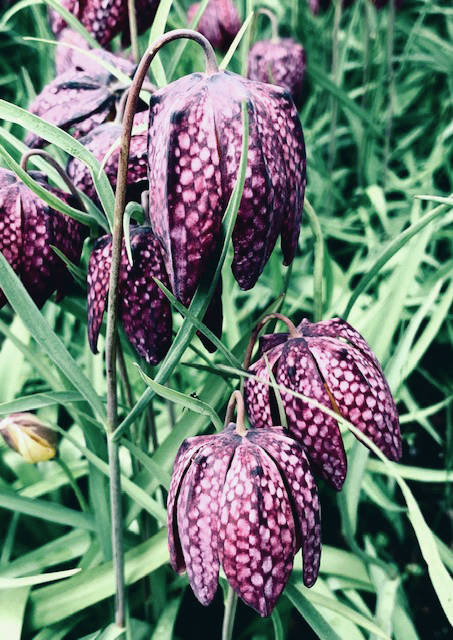There is a rosa rubrifolia/glauca in the corner of the East Garden that puts on an excellent show mid-summer. The blooms are understated but the foliage is lovely, a deep burgundy with navy blue undertones. The same coloring is repeated in the canes. In the winter this shrub glows and, although i’ts easy to miss in the summer, in the winter it is very visible from the house, and a joy to behold.
Well, I have ignored its well being forever, so decided to take a good look at it yesterday. Pruners, loppers, saw in hand I sashayed out there and was immediately impressed at how woebegone it has become. Apparently the blooms and foliage have hidden a multitude of sins for the last many years.
As I’m cutting, sawing, trimming and feeling like a very neglectful gardener, I felt like I was faced with a dilemma — keep cutting, stop cutting, ask John to take a chain saw to it and cut it completely down. What to do? The pile of trimmings was significant and I wasn’t finished.
Then the grands paid a visit and Cecilia, Luca and Flora joined me in assessing the rose. They were shocked and dismayed that I was considering annihilation. But it was Luca’s comment that turned the tide: “Why would you cut down anything that has leaves?” Now that’s some pretty clear logic. Wait I will. We’ll all see how this poor thing manages the summer.
I’ve pruned the black currants. Now there was a satisfying task. Once established (and it takes these shrubs about a nano second to do just that) they quickly became wild. It was difficult to reap the harvest last summer as the branches were so twisted together and dragging on the ground. An all-around mess of a plant, and, as much as I love black currants, I do not love a messy shrub. I researched how to deal with it and when I felt confident I went after all four of them with the pruners. They certainly look much better and I won’t need to devise any kind of support system for them. The proof will be in the harvest.
These berries are so easy to grow and the fruit’s flavor is unique. It may take a little getting used to but the effort is worth it. They are incredibly easy to start from a branch. If you know someone with a few of these ask them to propagate some for you.
Which brings me to: starting shrubs from branches. I think the most effective method is to choose a branch near the ground, break it part way through, nestle the break in the soil, pin it or put a weight on it to hold it in place and allow it to develop roots while still being supported by the mother shrub. By next season you will have a viable shrub. I’ve done this with spirea, mock orange and lilac. I also will fill a pot with compost, take cuttings and shove them into the pot. You will be able to tell within a few days which ones will take and which need to be tossed. Again, next season you’ll have a new shrub.
Whoever said that I needed any kind of ground cover? Well, of course I know, but I’ll let that go. Ground covers are a curse in a small garden. And this is a small garden. I spent the afternoon attempting, for the millionth time, to remove the white violets from here and there in the perennial beds. I didn’t get very far — they are stubborn. They started out as an understory for the bleeding hearts on the north side of the house. Perfect, and they are still perfect there, but they managed to move all the way to the south side of the house and parts in between. Drat. Be wary when you are offered ground cover.
The vegetable garden is interesting. The lower bed to the west was the last to thaw out and I didn’t give it enough time to dry out and warm up and I, and Packman broccoli and purple cabbage, are paying the price of my impatience. At first I thought they had been struck by cut worms, but on close inspection they simply rotted. I could start more and have a rolling harvest or I could declare a crop failure and buy starts from one of our most excellent local nurseries, or do both.
This is also the perfect time to take a look at what you planted from seed — such as peas, and any of the greens, and take note of any empty slots so you can pop a seed into place now. You certainly do want to maximize your space. I refer to this task as filling in the blanks.
Do you have tomatoes? Are they in bloom? Have you been SHAKING the plants to fertilize the blooms? That’s all it takes, a quick and gentle shake and you will have tomatoes. Nothing fancy, just shake.
How’s that compost pile going? My deepest wish is that you have embraced the compost pile/bin/tumbler whatever it is that will get you to use your waste instead of taking it to the landfill. Remember to water the layers and I really think covering the pile helps it to heat up and get going. If it’s stalled, stick your fork in there and stir it up, giving it some air. You can do this.
Rosemary Fitzpatrick is a longtime Homer gardener and has been writing Kachemak Gardener since 1990.


